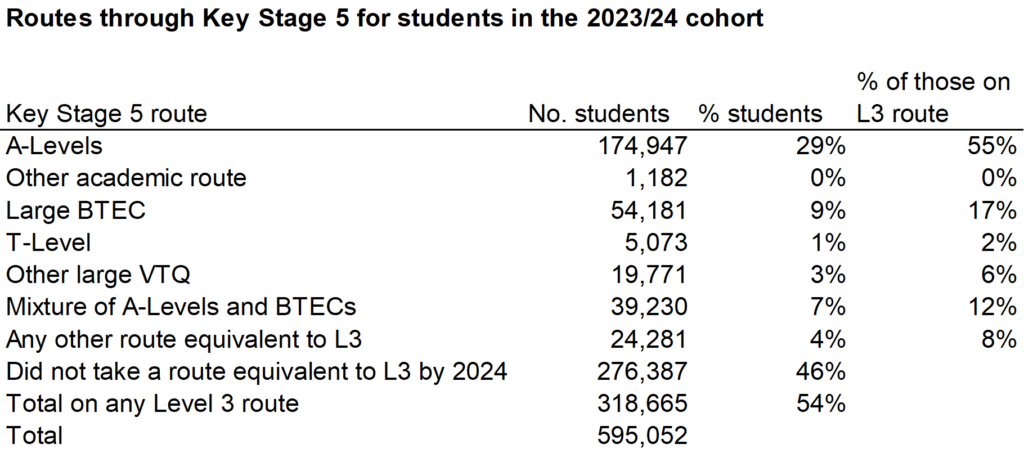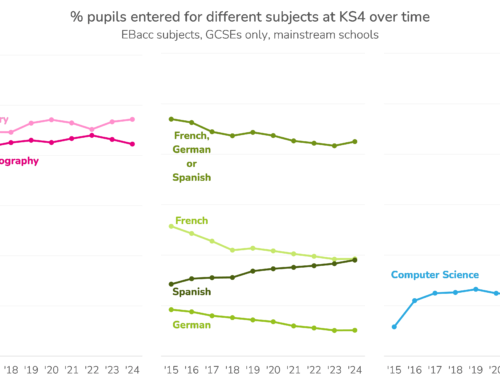There’s a brand-new post-16 qualification in town. Or rather, there will be at some point in the near(ish) future.
The new qualifications, to be known as V-Levels, were first announced before half-term in the post-16 education and skills white paper. They are based on recommendations from the Curriculum and Assessment Review Final Report, and the government expanded on the plans in their response to the review.
V-Levels will be Level 3 vocational qualifications that will sit alongside A-Levels and T-Levels. They’ll be similar in size to an A-Level to allow them to be easily combined with either other V-Levels or A-Levels.
With further details yet to be determined, and a consultation on the way, we thought it would be interesting to look at the routes students are currently taking through post-16 education, and what this can tell us about the students who might take V-Levels in the future.
Sign up to our newsletter
If you enjoy our content, why not sign up now to get notified when we publish a new post, or to receive our half termly newsletter?
Data
I’ll be using National Pupil Database (NPD) data from the KS5 student and exam tables from 2023/24, and the KS4 pupil tables for 2021/22. I’ll focus on students who completed KS4 in a state-funded school in 2021/22.
We’ve defined a small VTQ as a Level 3 vocational or technical qualification that’s the equivalent of less than two A-Levels. A large VTQ is defined as a Level 3 vocational or technical qualification that’s the equivalent of at least two A-Levels.
Routes through post-16 study
As the white paper flags up, there are a lot of possible routes through 16-19 education – and a lot of them don’t involve Level 3 qualifications at all. In the table below, we’ve simplified them into eight different routes.

Just under half of those who completed KS4 in 2022 did not go on to complete a route equivalent to Level 3 by 2024. Some of these students will have completed qualifications equivalent to Level 2, either in 2023 or 2024, and some will have gone on to complete Level 3 equivalent qualifications in 2025.
Of those students who did complete a route equivalent to L3, over half were taking A-Levels or another academic route (like the International Baccalaureate or a PreU qualification)[1]. Another quarter were taking large BTECs or other vocational and technical qualifications (VTQs), or T-Levels. And 20% were taking either a mixture of A-Levels and BTECs, or another combination of leading to Level 3, typically including either a combination of VTQs and A-Levels, or a combination of several VTQs.
That 20% – around 64,000 students – are perhaps the obvious group for whom V-Levels could be a good fit. But they might also be appropriate for others: some of those currently taking large VTQs, or some of those working below Level 3, perhaps in combination with qualifications at Level 2 or below.
Which institutions are likely to offer V-Levels?
It’s often, although certainly not always, the case that students pursuing an academic route through Key Stage 5 attend school sixth forms and sixth form colleges, while those pursuing technical or vocational routes attend FE colleges. But what about V-Level students, who may be combining V-Levels with A-Levels?
Here we’ve broken 2024 students down into three groups: those who took A-Levels or another academic route, those who took large VTQs (including T-Levels) and those who took small VTQs in some combination. The third group are the 64,000 identified above as those most likely to be a good fit for V-Levels.
The chart below shows the type of institution students from each group attended during KS5.

Most of what we might think of as the potential V-Level group attended colleges, but a very substantial minority (38%) attended schools. If V-Levels follow a similar pattern, we might expect them to be popular among both school and college students.
Having said that, it’s worth noting that a lot of schools with sixth form students don’t appear to offer any small VTQs, and those that do often offer a very limited range of subjects compared to colleges. The table below shows the number of different small VTQ subjects that KS5 students were for entered for in 2024, by institution type.[2]

The majority of schools with Key Stage 5 students didn’t have any students entered for small VTQs. Those that did had entries in a very limited number of subjects, the majority just one. In contrast, the vast majority of colleges had entrants to small VTQs, and most had entrants in a range of subjects, with the majority offering ten or more.
Which subjects should V-Levels cover?
So, we’d expect colleges to offer a much wider range of V-Levels than school sixth forms, but what subjects might V-Levels cover?
This question will be the subject of a consultation, but the government has said that they will be linked to occupational standards. It’s possible, then, that they may look something like a shorter version of a T-Level, in which case they might simply cover the same subjects as T-Levels. There is some suggestion that the range of T-Level subjects may expand if there is demand.
But we can do at this point is look at the BTEC and other VTQ subjects that were most popular with the 2024 cohort. V-Levels may or may not directly cover these subjects, but they are clearly areas where there’s demand for vocational qualifications.
The chart below shows all of the small VTQ subjects with more than 2,000 entries.

The most popular subject shown on the chart, social science, actually includes just two small VTQs, the WJEC Applied Diploma and Applied Certificate in Criminology. Other popular topics include business studies, health studies, multimedia and sports studies.
I only show the most popular subjects here, but it’s worth noting that there were 143 subject areas with entries in 2024; this compares to 65 A-Level subjects. The Review does suggest that the number of V-Level subjects should be similar to the number of A-Level subjects, so we may see some considerable trimming of the number of subjects on offer when V-Levels are introduced.
Summing up
While not a direct replacement, we might expect V-Levels to fill the position currently being taken by small Level 3 VTQs, including BTECs, OCR Cambridge Technicals and other qualifications.
There’s clearly demand for small VTQs that can be taken in combination with one another, or with A-Levels. While details are still to be decided, we’d expect V-Levels to mostly be taken by students in colleges as opposed to schools, and we’d expect colleges to offer a much broader range of V-Level subjects than schools. Having said that, we’d still expect a substantial minority of schools to offer a more limited range of V-Levels.
The range of subjects offered at V-Level will be subject to a consultation, and will be linked to occupational standards and key employment sectors, but will likely also take into account the most popular small VTQ subjects for recent cohorts, with criminology, business studies, health studies, multimedia and sports studies top of the list.
[1]: The numbers taking alternative academic routes are very small, hence we group them together here.
[2]: Note that the small number of pupils for whom no institution type can be determined have been rolled into the ‘school’ category; this number is too small to report separately.
Want to stay up-to-date with the latest research from FFT Education Datalab? Sign up to Datalab’s mailing list to get notifications about new blogposts, or to receive the team’s half-termly newsletter.









Leave A Comment